Visitor Action Personalization Playbook for Shopify

WIN NEW CUSTOMERS: every day, 90% of your visitors leave before finding a product of interest – unlock this untapped market with context-based personalization.
Why visitor action personalization?
Here is a true life story.
The director of personalization of one of the major online retailing companies once received a nasty email from the CEO telling him that he should either fix his personalization system or lose his job.
The CEO’s email was prompted by a customer’s complaint that the company’s personalization system was making offensive assumptions about the lifestyle of this customer and was recommending inappropriate products to that person.
Upon a closer examination, it was discovered that the customer once bought an item as a gift for his friend, and the personalization system started recommending related products to that customer making implicit assumptions about his lifestyles, which infuriated that customer.
This story and others like it reveal the serious shortcomings of conventional personalization systems that use historical purchase information to infer customer behavior, without considering the context in which these purchases were made.
Social media has changed customer experience expectations
Early on, social media companies embraced the use of Artificial Intelligence (AI) and in the process changed the nature of the online experience. Their AI algorithms are ‘reading the user’s mind’ and serving the right content at the right time, so their users don’t need to do anything besides enjoy the experience.
SOCIAL MEDIA APP EXPERIENCE
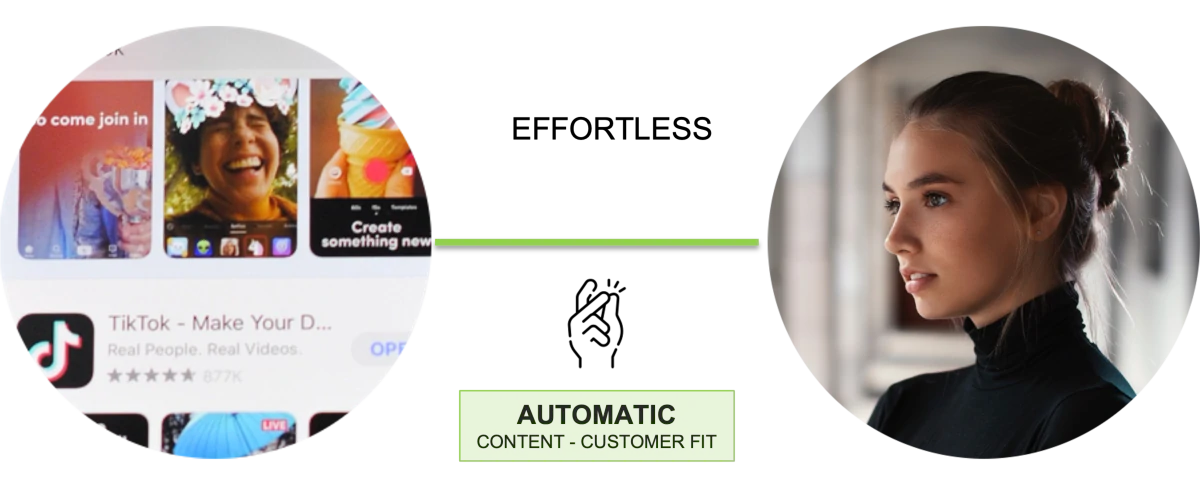
You might be asking what that has to do with ecommerce.
The answer is very simple. Social media users, comprising billions of people, are now expecting similar ‘addictively’ easy-to-use ecommerce shopping experiences, which are mostly non-existent.
Think about how you feel when you visit an ecommerce site and have to go through search, navigation, product filtering, and other obstacles, before you can find and spend money on what you’re actually you’re looking for.
No wonder KPIs (Key Performance Indicators) from social traffic are super low compared to other channels.
Not fun!
ECOMMERCE EXPERIENCE

That’s why ecommerce companies must up their game to stage equally enjoyable shopping experiences.
Money can’t buy you revenue growth
People and budget resources in a typical ecommerce company are disproportionately allocated to demand generation.
That strategy has hit the ceiling and it is now producing diminishing returns, if not losing money, for a significant percentage of merchants.
EXAMPLE: PAID SEARCH AD SPEND
Paid search is the ‘bread-and-butter’ of demand generation marketing.
Considering that Google is virtually the only game in town, it’s not surprising that CPC (cost per click) prices are increasing every year.
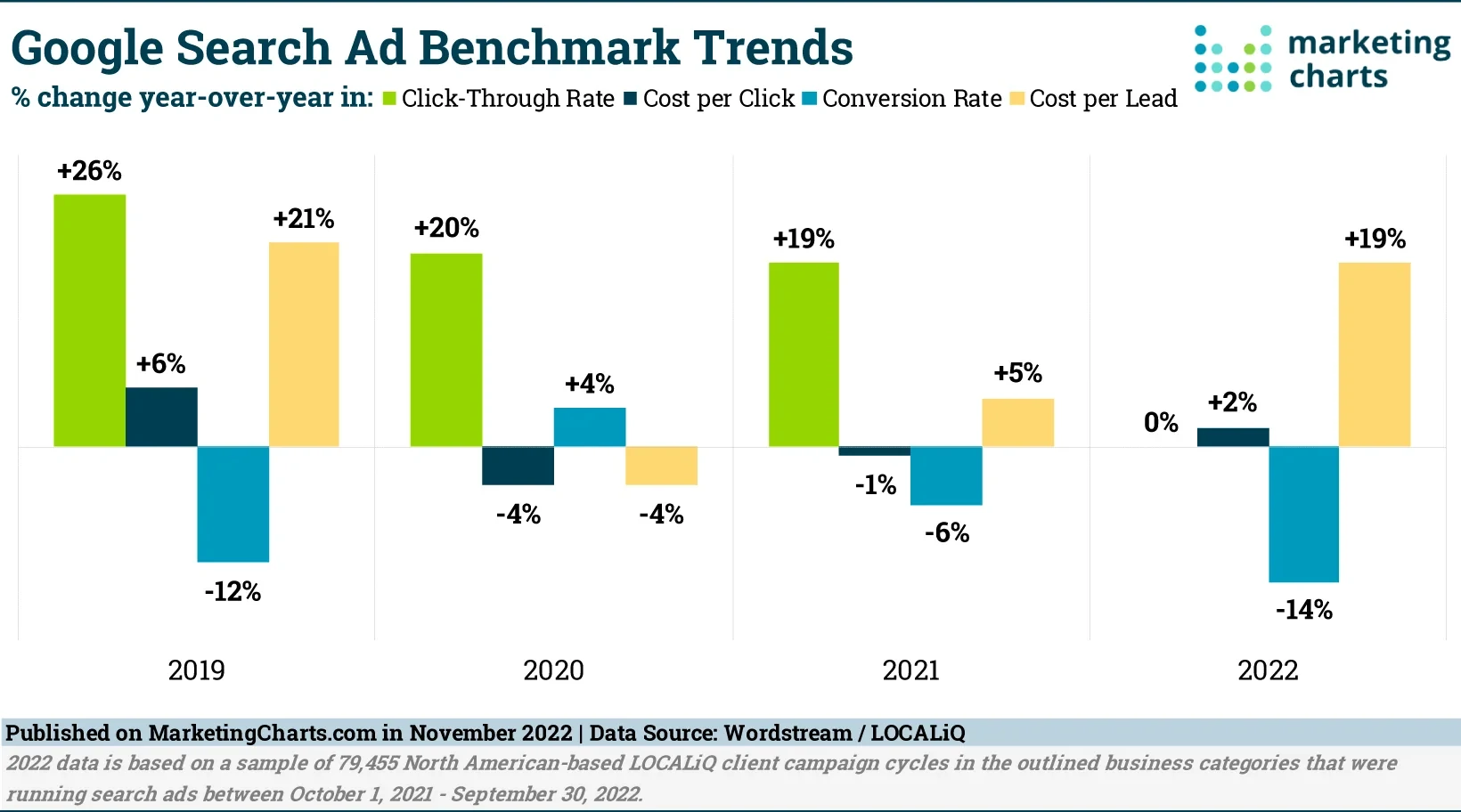
Online merchants have very little margin for cost increases or decreases in conversion rate.
To illustrate the point let’s use the average CPC cost numbers provided by Cake Commerce together with simple break-even analysis.
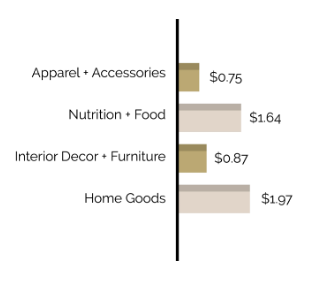
Let’s do some simple math to determine the CPC break-even point for a hypothetical ecommerce brand:
Revenue assumptions:
| AOV (Average Order Value) | $100 |
| CR (Conversion Rate) | 2.5% |
| GRPV (Gross Revenue Per Visit) | $2.50 |
Cost assumptions:
| PNM (product net margin) | 50% |
| COO (cost of operation) | 20% |
| Break-even CPC cost | $0.75 |
KEY POINT: do your own calculations to determine if your brand can make any profit with paid search advertisement – in most cases the answer is NO.
Steadily declining eCommerce growth rate
After a short two-year COVID blip ecommerce growth rates are returning back to a 20-year declining growth trend.
This long term downward trend is creating a need for new innovations in how to increase ecommerce market potential.
It’s about product-visitor fit
The main goal of every business is to achieve a great product-market fit. This drives market demand and overall business success.
However, when it comes to ecommerce, where everything happens in real time, the product-market fit objective becomes a very specific product-visitor fit.
The web visitors are already there and your immediate mission is to help each one of those visitors easily discover products they like and are ready to buy.
Fundamental flaw: assumption that visitors will connect with products on their own
The self-serving nature of ecommerce was a force that disrupted traditional retail. Visitors coming to an online site, finding a product of interest, and buying it, all on their own.
Unfortunately that self-serving model has now reached its limits.
Today’s shoppers, mobile shoppers in particular, act differently. They are less and less likely to put much effort into exploring what a brand has to offer.
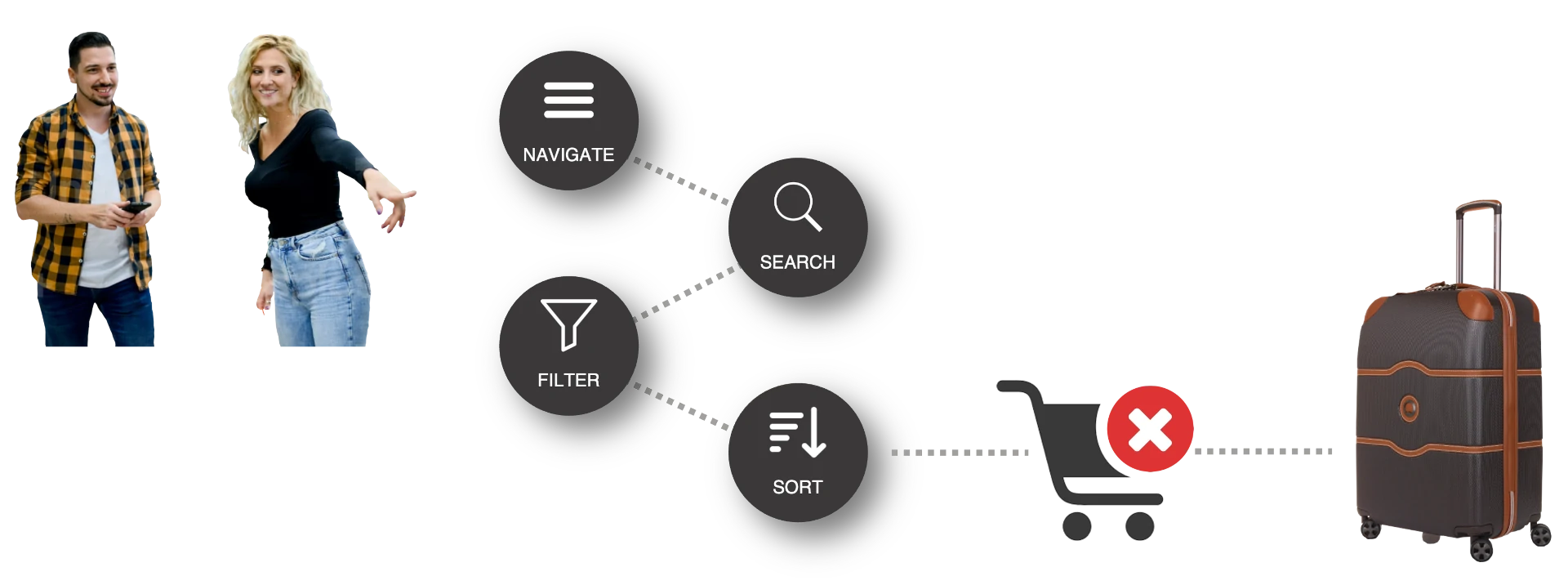
Instead, if a product they are interested in is not in the plain view, within a short period of time, shoppers are likely to turn around and leave, often for good.
That’s why advanced technologies, like personalized product recommendations, have become crucial in keeping ecommerce shoppers interested and committed to purchasing.
Personalization challenge
One might say, why reinvent the wheel, let’s license the algorithms used by social media companies and apply it to ecommerce.
We wish it were that simple. The two types of businesses are very different.
Social media companies have access to rich user demographics and social app usage histories. This volume of actionable data enables effective AI algorithm training and very reliable predictions.
In the ecommerce world the data situation is the opposite.
On a typical site, less than 6% of visitors are returning customers with limited prior shopping history. Additionally, only a small percentage of a product catalog has reliable sales data. And, worst of all, 90% of visitors coming to a site never find a product of interest and leave without a hint of what they actually needed.
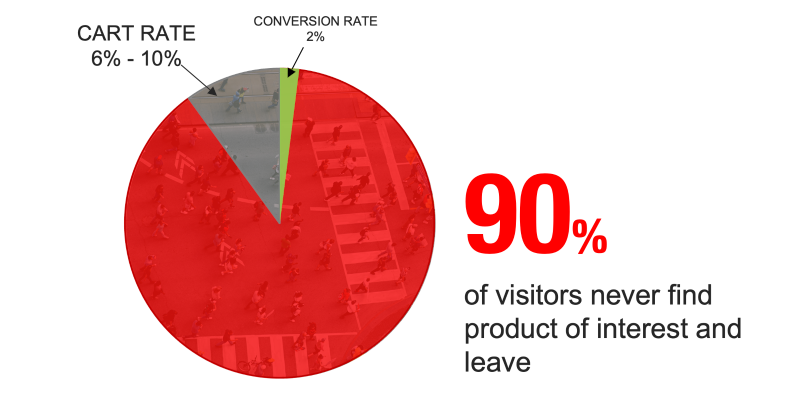
Limits of conventional personalization solutions
One can find hundreds of personalization apps on the Shopify app market place.
They all use ‘personalization’ or ‘AI algorithms’ terminology leading merchants to believe that all the apps have similar technical capabilities and that the main decision criteria should be the price or ease of use of the app.
These conventional personalization applications represent the first generation of personalization technology. They are a step in the right direction and often provide 10x ROI.
However, conventional personalization solutions cannot match the revenue growth possibilities that advanced personalization solutions can provide.
Their approach is based on using past purchase data to develop prediction models for future shoppers. It’s like looking in the rearview mirror whilst trying to drive a car forward.
When do conventional personalization apps work?
Conventional personalization works well for sites with a large percentage of returning customers and repeat purchases.
When do conventional personalization apps fail?
Conventional personalization fails for sites with a large percentage of new visitors and when returning customers are in need of something different than what they purchased in the past.
Visitor actions as buying signals
The new and advanced personalization approach solves sparse data problems and unlocks the revenue potential of the 90% of unknown visitors coming to a site. This new approach uses visitor actions as buying signals, resulting in far better prediction models to recommend the most relevant products in real time.
One of its most notable practitioners is Amazon. We suspect that this was one of the secrets behind the amazing success of their marketplace.
Here’s an unexpected twist. Even though Amazon has a huge percentage of returning customers and super rich historical product sale data, they discovered that what visitors are actually doing during a live buying session is a much better predictor of their product needs than historical data alone.
For example, if a customer is showing an interest in a particular product category, Amazon’s marketplace will leverage that signal to recommend products or offers that are likely to be of interest in that category, as opposed to simply showing products that the shopper was interested in during a prior visit.
This approach is a game changer! By using visitor action personalization, every ecommerce company can create a more engaging and satisfying buying experience for their customers, which will ultimately lead to increased loyalty and sales.
Value of action and context-based predictions
So, if the director of personalization from the opening story of this post had used visitor action personalization solution the retailer would likely not have received a customer complaint, nor a nasty email from the CEO.
Action based personalization solutions use shoppers’ actions to adapt and recommend the most relevant product in real time.
Obviyo’s Recommend app, a visitor action driven personalization solution powered by the same algorithms used on Amazon’s marketplace, consistently delivers strong key metrics when shoppers engage with personalized recommendations:
-
- Page view rate: +342%
- Time on site: + 277%
- Conversion rate: +389%
- Revenue per visit: +545%
Growth Bots and action based personalization playbook
To reduce the complexity of the solution and to enable every Shopify brand to effectively compete with the ‘big boys’, we built the Obviyo Recommend & Personalize revenue growth automation app that provides the following game changing capabilities:
- Algorithms: the app is powered by the same machine learning algorithms that drive personalization and product recommendations on Amazon
- Growth Bots: eCommerce components designed for a wide range of use case scenarios, driven by integrated real-time data, and powered by the right type of algorithm;
- Playbooks: a blueprint to inspire and to guide with step-by-step actions;
In this post, we are introducing our ‘Action based personalization’ playbook and a curated set of Growth Bots you need to stage the most effective personalized product discovery and buying journey.
Story behind the playbook
The main goal of this playbook is to help you jumpstart your personalization initiative. In the process we hope to help you develop a Revenue Growth Automation (‘hacking’) mindset that will enable you to continually iterate and improve your store results.
To help you easily follow the playbook logic we segmented web visitors into 5 dominant audiences:
Non-customers
These are web visitors who are leaving your site without ever buying anything – on average, non-customers represent 90% of all your traffic
Returning visitors
These are web visitors who recently visited your site – on average, returning visitors represent 30%-40% of all web traffic
Likely buyers
These are web visitors who are showing signs of interest in your products – on average, likely buyers represent 10% of all web traffic
Existing-customers
These are web visitors who purchased at least once from your site – on average, existing customers represent 6% of all web traffic
Abandoners
These are visitors who are showing signs of intent to exit the web page – on average, abandoners represent 97% of all web traffic
The biggest challenge in personalization is relevancy. If your personalized recommendations are irrelevant chances are customers may abandon their buying journey.
To solve the issue of relevancy you shouldn’t hesitate to leverage your customer knowledge and introduce manually provisioned or rules based options. However, the best results are achieved when using visitor action personalization algorithms.
Audience 1: Non-customers
On average, 94% of all your web visitors are non-customers. They are most likely seeing your brand and products for the first time in search of items that will meet their need for comfort, connection, variety, or uniqueness.
Your goal is to establish a quick connection by expanding the number of ways potential buyers can discover products of interest – otherwise the sales opportunity is lost, often forever.
Personalization By Arrival Page
PLAY: Reduce bounce rate by increasing relevancy of the first page viewed.
WHY THEY WORK: The first page view is a proxy signal for visitors’ implied interest – by presenting personalized product recommendation based on the arrival page you will increase engagement even if the first page is not showing products visitors expected to see.
PLACEMENT: Home, collection, and product pages
Personalize By Geo Location
PLAY: Increase the initial engagement with personalized recommendations of products popular with visitors arriving from different geo locations.
WHY THEY WORK: Geo location can be a proxy for visitor product affinity. For example, visitors from Los Angeles might have a tendency to buy certain products different from visitors from another region.
PLACEMENT: Home, collection, product pages
New Arrivals
PLAY: Create a perception of exclusivity while making visitors more curious about your products.
WHY THEY WORK: Shoppers have a built-in expectation that something new must be better than what came before. Displaying the latest products will encourage people to purchase before anyone else.
PLACEMENT: Home, collection page
Audience 2: Returning visitors
Repeat visits to your store are signs of interest in your brand and products.
It is essential to stage buying experiences that turn multiple visits into a seamless buying experience and leverage prior activity data to adapt to visitor needs in real time.
Re-engage With Returning Visitors
PLAY: “Stitch” together highly fragmented buying journeys by presenting products a visitor viewed during prior visit(s).
WHY THEY WORK: Only 17% of consumers browse with intent to purchase on a first visit. With all this back and forth it can be tricky for them to remember items they’ve already viewed.
PLACEMENT: Home page
Inspired By Recent Product Views
PLAY: Help customers to further explore related or complementary items to those they have already viewed.
WHY THEY WORK: These recommendations will introduce customers to products they didn’t previously know you offered, further earning their confidence that you’re the best retailer to satisfy a particular need.
PLACEMENT: Home, confirmation page
Personalization By Product Type
PLAY: Accelerate product discovery by presenting relevant products of the same type.
WHY THEY WORK: Relevant items of the same type further increase the relevancy of recommended products and drive more product views and ultimately more sales.
PLACEMENT: Product pages
Audience 3: Likely buyers
Visit to multiple product pages or click on the add-to-cart button are signals of interest in your brand and the types of products your shoppers are interested in.
This information is super valuable and it should be further amplified by upsell or cross-sell of related products.
Cross-sell Complementary Items
PLAY: Enrich product discovery process with cross sell of highly relevant items.
WHY THEY WORK: Shoppers are unaware of the breadth of your product catalog. Recommending items that are frequently bought together will alert shoppers to products they didn’t previously know you offered.
PLACEMENT: Product pages
Add To Cart Cross-sell Pop-Up
PLAY: Cross-sell to buyers who just completed an order with recommendations based on items they viewed during the buying session.
WHY THEY WORK: Trigger a pop-up after a shopper clicks on the ‘Add to Cart (Bag)’ button that displays complementary items that they should also consider buying.
PLACEMENT: Product pages
Cross-sell – Bought Together
PLAY: Showcase complementary products together, with the ability to add multiple products to the online shopping cart with an ‘add-to-cart’ button.
WHY THEY WORK: When shoppers browse an item, they are often unaware of available complementary products and accessories and are hesitant to go through multiple cycles of discovering and selecting different products. However, when a merchant showcases product add-ons, a customer can quickly select and buy multiple products at once.
PLACEMENT: Product pages
Audience 4: Existing customers
Once shoppers click on the add-to-cart button the buying experience changes. This action generates a strong signal of interest in your brand and the types of products your shoppers are interested in.
This information is super valuable and it should be further amplified by upsell or cross-sell of related products.
Repeat Purchases
PLAY: Make repeat purchases personalized and as convenient as possible.
WHY THEY WORK: If you are selling products that need to be periodically replenished, the probability is high that customers will return to buy again. That’s why you need to make the repeat purchase process as easy as possible.
PLACEMENT: Home
Post-Purchase Personalization
PLAY: Cross-sell to buyer who just completed an order with recommendations based on items viewed during the buying session.
WHY THEY WORK: It is essential to continually educate your shoppers on the depth of your product catalog. The order confirmation page is valuable real-estate that should be used to recommend additional products that buyers can consider now or in the future.
PLACEMENT: Confirmation page
Audience 5: Abandoners
Once shoppers click on the add-to-cart button the buying experience changes. This action generates a strong signal of interest in your brand and the types of products your shoppers are interested in.
This information is super valuable and it should be further amplified by upsell or cross-sell of related products.
Session Recovery – Desktop
PLAY: Reduce site abandonment rate through pop-up overlays when a user displays signs of exiting the site.
WHY THEY WORK: Often visitors are plagued by the paradox of choice, with too many options leading to analysis paralysis. In these instances, overwhelmed visitors may attempt to navigate away from the site.
PLACEMENT: Sitewide
Cart Recovery – Desktop
PLAY: Combat cart abandonment with exit-intent triggered overlays to remind shoppers about incomplete checkout, while also featuring relevant product recommendations to recapture shoppers’ attention.
WHY THEY WORK: With cart abandonment on desktop devices exceeding 70%, preventative measures are key to eliminating potential revenue loss.
PLACEMENT: Sitewide
Conclusions
Ecommerce personalization is a popular talking point but practiced by only a small percentage of large online brands.
An implementation of a personalization solution might seem complex and out of reach for the majority of Shopify merchants. In reality, with Obviyo’s playbook and ready-to-use Growth Bots, most Shopify merchants should find it easy to implement.
This blog’s mission is to provide context behind the short list of personalization Growth Bots that each Shopify site should have.



